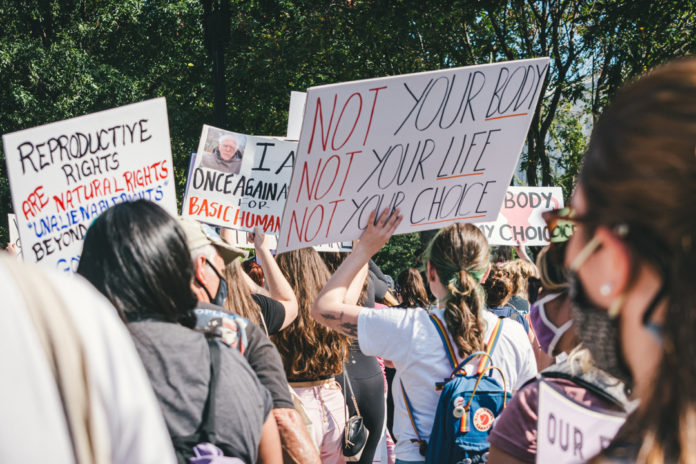If you’re used to ignoring the plethora of ads plastered all over the average Translink Skytrain station, it can be easy to miss, but it’s there; at the Commercial and Broadway stop on the Expo line in Vancouver, between the community college ads promising second chances and posters warning riders to stand back from the tracks, an offer for help is displayed. A poster advertising a “pregnancy crisis” counseling service, for those who find themselves looking for “options.” It greets riders just before they exit the platform and head out on to the street, and it’s an immediate signifier of the presence of an abortion clinic in the neighbourhood — but not for the reason you think.
With the recent leak of a draft ruling that would overturn Roe v. Wade threatening the status of abortion as a constitutionally protected right in the U.S., the topic has been on the forefront of many minds. To your average pro-choice Canadian, this may seem like another on a long list of things that draw a sharp line between our two countries; from our publicly funded healthcare model, to our immigration-friendly federal policies, Canadians almost make a national sport out of being smug about our human rights compared to our neighbours to the south. After all, abortions are legal and freely available in our country. Which brings me to our second favourite national pastime: being blissfully, apathetically unaware of our own history.
The fact is that there is no law guaranteeing abortion access in Canada. Decriminalized in 1988, the Supreme Court of Canada struck down Canada’s abortion law as unconstitutional, citing that the law infringed upon a woman’s right to “life, liberty and security of person.” From then on, abortion was left to be treated like any other medical procedure — governed by provincial/territorial governments and medical regulations. Surely, this must mean that abortions are just as accessible and available as any other medical procedure you might need, right?
Not quite. If you live in the Fraser Health region — the largest health authority by population in B.C., and an area that includes regions as far east as Hope — your options are limited as there are, as of publishing, no publicly listed abortion providers in the region The closest listed clinic is in east Vancouver, near the intersection of Broadway and Commercial; a long trek for those who live in the valley’s most rural communities.
But what about those counseling centres? When you Google “abortions Abbotsford,” the top results show local addresses and phone numbers. Like that poster at Broadway station, we’ve all seen ads for “compassionate” and “judgement-free” help around our community. Unfortunately, they’re not nearly as open-minded as their carefully worded posters would suggest.
I reached out to the closest one to me (and the top result on Google), the Hope for Women Pregnancy Centre, to request an interview for this article and was surprised when they declined.
Joyce Arthur, the executive director of the the Abortion Rights Coalition of Canada (ARCC), a pro-choice group that works to protect abortion rights and access, gave me some insight.
“There’s over 300 anti-choice groups in Canada, and half of those are these crisis pregnancy centres,” said Arthur. The ARCC maintains lists of all the anti-choice groups operating in the country, and so-called “pregnancy care centres,” which includes our local “Hope for Women” chapter. There are more than 15 anti-choice groups operating in the Fraser Valley, and many of them use co-opted language of pro-choice and feminist movements to camouflage.
“At least one in three people who can get pregnant will have an abortion at some point in their lives,” claimed Arthur. “If people start sharing their abortion story, they’ll find that other people around them have also had abortions too…ordinary people have abortions.” For the cost of the top ad rank on Google, organizations can catch vulnerable people looking for options before they can make it to a healthcare provider or a legitimate helpline (like the one operated by BC Women’s Hospital) and can give misinformation about their options.
“They’ll kind of exaggerate the side effects, make it much worse than it really is,” Arthur says. “They’ll never, ever talk about the side effects or medical risks of pregnancy and then childbirth, which are far greater than having an abortion.”
Recent polls have shown that as many as four out every five Canadians support a woman’s right to choose, yet there is a lack of funding and a lack of provincial and federal policy enforcing and protecting the service, resulting in many regions in this country — including the Fraser Valley — being underserved.
The Managing Editor is responsible for providing support to the Executive Editor in respect to editorial workflow and administration, and an educational resource for sectional editors and volunteers. The Managing Editor is also responsible for internal editorial and volunteer relations.



